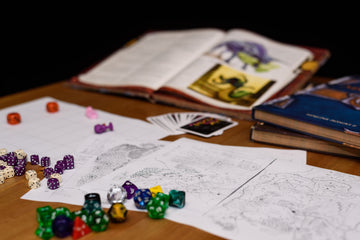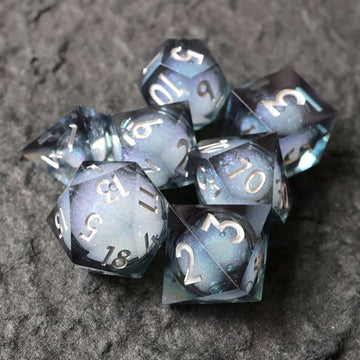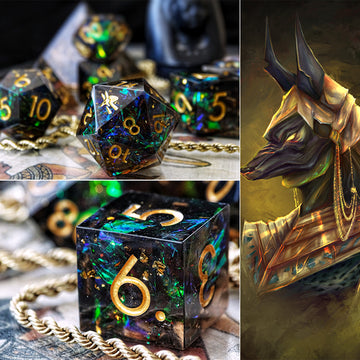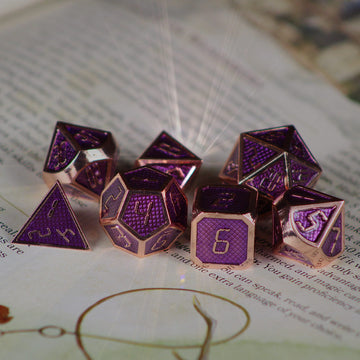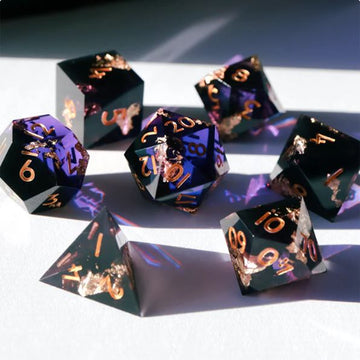11 Laws (Plus a Story!) Designed to Make Them Understand the Spirit of the Game and Want to Play Again
By Riley Rath
Teaching anyone to play Dungeons and Dragons is a formidable task.
I mean, learning board games is notoriously tedious (just watch Aunty Donna and ProZD and you'll see what I mean). DnD is all that and then some... its rules require entire volumes!
Not only that, but most people have never played anything like a tabletop role-playing game. Because of their unfamiliarity, they don't just have to learn rules... they also need to learn what it means to be a player.
But here is the sad part:
Even though tabletop RPGs are blessed to be one of those games you can learn by playing, it's usually an unpleasant experience for beginners.
This blog post is the true story of how I taught my family to play "DnD" with practical takeaways you can use anytime to teach anyone.
I call them the "How to Teach DnD Laws."
Not suggestions... not rules... hard, immutable LAWS. The best way to make sure everyone has a good time learning how to play a TTRPG.
That is how strongly I insist on following them.
Why?
Well, for one, they have worked time and time again with all sorts of different new players.
But also... we only get one chance to make a TTRPG "first impression."
And if that first D&D impression is bad... it's highly unlikely they will try again.
It sucks when you KNOW a friend or family member would love a 5e adventure. But instead of seeing their eyes light up as they slay a dragon, they shrug their shoulders in apathy, yawn of boredom, or anxiously say it's not for them.
What can we do better to not turn them away?
Read on and find out.

DnD Story: Journey BACK to the North Pole
"Riley... I'd be down to try D&D on Christmas."
That's what my sister told me on December 23rd as we gathered downstairs to watch Netflix's Klaus (seriously underrated)... and my jaw hit the floor.
For years I had offered to run a "family Christmas one shot"... it was always at the top of my list for family holiday activities.
And every year I would get an eye roll, a sigh, or a sarcastic "hard pass."
But this year, for some reason, not only was my sister open and willing, but so was my mom... dad... brother... and brother's wife.
Apparently all it took was one vote and the others would join in.
How to Teach DnD Law 1: Wait for Them to Be Ready
I... couldn't... believe it.
To be honest, I only kept the Christmas one shot on the list as a sort of joke; I never actually expected it to happen this decade.
And because it was thrown at me at the last minute, all my DM tools were back at home: dice, books, computers with the auto logins I forgot long ago...
Everything.
But before me was an opportunity that doesn't present itself very often... and may never present itself again.
So with less than two days to plan, I began crafting a 2-hour Christmas adventure from scratch. A harrowing, holiday journey for a ragtag group of Christmas elves... stranded far from Santa's workshop...
How to Teach Dnd Law 2: Use Lore They Are Familiar With
(2 days later...)
Christmas morning... presents have been opened... 12:30 pm breakfast has been eaten... new clothes have been fashion-showed.
And finally everyone sits down at the dinner table, warm and hard drinks in hand.
Before them on the table is their "battlemap": a mini winter wonderland.

I took a cherry log destined for the fireplace, a rock and some pine cones from the backyard, and all the miniature Christmas trees my mom used to decorate the house.
Put it all on a standard white tablecloth and boom... winter encounter time!
How to Teach Dnd Law 3: Play the First D&D Session in Person With Minis and Terrain
But as detailed as the terrain was, their individual place setting was sparse. All they had in front of them were two things: 1) four six-sided dice, 2) a blank piece of paper and a pencil.
"Where is the character sheet?" asked my brother, who had played one or two times before.
"There isn't one," I told him. "I want you to write down the following words: Strength... Dexterity... Constitution... (etc.)"
I then explained what each of those abilities were, gave some examples, and then gave them a choice:
DM: "I want each of you to give one ability a +3, one a +2, one a +1, two a 0, and one a -1."
How to Teach DnD Law 4: Do NOT Start With a Standard Character Sheet
Too simple to mess up, right?
Nope... for a new player, even that is a bit too confusing. They struggled to understand what it meant to imagine their own character.
Thankfully, I had pulled out some old Warhammer minis from Jr. High:
DM: "Pick one you like, whose weapon you would like to use and go from there."
It was intuitive enough, and we made it through the skills section.
I then explained the dice... each of them had just 4d6. With no standard 7 dice set with a d20 in the house, I had cannibalized all the 6-sided dice from all the games in my parents' board game closet.
"Any time you do anything, you will roll all 4 of your dice, and add whatever ability modifier you have."
Mom, without skipping a beat: "What's a modifier?"
Brother's fiance: "It's those plus and minus numbers we just went over."
How to Teach D&D Law 5: Simplify the Mechanics
I told them to write down/choose from the following:
- Movement = 30ft
- Health = 15 - 25 pts of health (depending on the character)
- Armor = 14 - 19 (depending on the character)
- One of Snow White 7-dwarves' personalities
- One of the 7 deadly sins as a character flaw
- A single 2d6 healing potion
- Magic Ring with one spell (school of magic of their choice)

How to Teach DnD Law 6: Simplify Magic OR Only Play Martial Classes
All in all, the process took about 20 minutes. It was super scaled down and I had to look up a probability chart for four d6s in order to set the right DC. But each of their characters were simple and just different enough from one another for them to feel like their own.
Finally, I told them the most important thing:
DM: "Okay... so this is a game that relies heavily on imagination and teamwork. There are no winners and losers, nothing to 'Jenga'... we are enjoying an adventure together."

© Sony & Universal
Once they nodded... the explanation was over and the 2-hour hard limit for the one shot began.
And so, of course, we played our adventure in some sort of jolly Christmas D&D tavern... right?
Hell naw.
"SANTA'S SLEIGH PLUMMETS OUT OF THE SKY!!!!"
Hitting the spacebar, my dad's laptop begins blasting the most intense carol of the bells I could find.
I pulled out a wooden Santa's sleigh ornament, lifted it above my head, and slowly began to have it descend upon the table.

"Santa's reindeer have disconnected from the sleigh! Every alarm and meter across the dashboard is blaring and going crazy... WHAT DO YOU DO?!?"
After just a moment, they begin to speak up one by one.
"I try to reset the dashboard!" (Fail)
"I repair the engine!" (Fail)
"I deploy the parachutes...?" (Success!)
"I jump out of the sleigh!" (Mercifully stopped by a fellow elf)
Having slowed the descent, I continued:
"Hurdling through the blinding snow, you brace yourself for a crash landing. Moments later the sleigh crashes into the ground, flipping and turning across the forest floor, before skidding still in a burning heap. You each crawl out..."
How to Teach DnD Law 7: Start the Session Right in the Middle of the Action
DM: "Everyone roll Constitution."
Dad: "What does that mean?"
Brother: "It means roll the 4 dice and add the number next to the word 'Constitution.'"
Dad: "Oh right, right."
(Everyone rolls)
"Most of you remain unscathed. For those that failed, roll a d6 and subtract it from your health."
Having landed, I then ask them to do what was maybe their favorite part: revealing their Christmas elf's silly Christmas name: Schnelfie (in-law), Tingle (sister), Butterrum (mom), Nicolai von Dorcheski III (brother), and Grumbus (dad).

Introducing our heroes... Schnelfie, Tingle, Butterrum, Nicolai von Dorcheski III, and Grumbus!
Clearly they had no trouble getting the D&D character naming part right. But as silly as their names were, they were in a deadly serious situation.
Santa's sleigh was in ruins, they were without any weapons, and were stuck in a blizzard. But worst of all, they were on the outskirts of "The Mantle of St. Nick": the protective barrier that separates magical winter wonderland from the hostile North Pole.
But out in the snow... something even worse was waiting for them.
"Beneath the howling winter winds, you each hear a deep, low groaning. You peer through the blizzard and see figures aimlessly floating across the snow. Your hearts are seized with icy fear when it dawns on you what they are..."
"... Ghosts of Christmas past!"
I took out the minis that sparked the "ghosts" idea in the first place: 7 different "army of the dead" LOTR minis.

"With no weapons to speak of, and only your magic rings, you must get past the ghosts, pass through the Mantle of St. Nick, and get back to Santa's workshop."
How to Teach DnD Law 8: Give Them a Clear, Obvious Goal
After asking me a lot of clarifying questions, they developed a stealthy strategy, hoping to use the blizzard and the terrain as cover.
Now, of course, their strategy didn't last more than 10 minutes.
By the end of it, they were sprinting as fast as they could away from a very angry abominable snowman.

But here's the thing... they learned as they played through the encounter!
They role-played, stealthed, performed, hid, and attacked. They experienced limited visibility and difficult terrain. They even experimented with magic, conjuring "Christmas bolas" to restrain the ghosts, and using another of the magic rings to create a forest illusion.
Over the next hour, the adventure continued. They wandered through the magical lands of the North Pole, overcoming challenges along the way.
They solved the puzzle of the 12 Days of Christmas birds in the peppermint forest.

They answered the riddles of Mr. Marshmallow at the lake of hot cocoa.

They defended a town of gingerbread people from the Rat King and his minions.

How to Teach DnD Law 9: Include a Variety of D&D Stereotypes
But finally, weary from the journey, they returned to Santa's village, all in one piece.

Equipped with weapons by the gingerbread villagers and healed up by their potions, they did what any self respecting elf would do... report directly to Santa.
Up the hill, through the gate, and... the door was open... hanging by a single hinge...
"You timidly step into Santa's workshop to see clear signs of a struggle: Santa's armchair is cloven in two... a bottle of maple syrup appears to have been thrown against the wall... toy blueprints are scattered on the ground. And Santa is nowhere to be found."
"One wall has a large bookshelf with a nutcracker on it. On another wall you see a roaring fireplace full of hot coals. A mistletoe hangs over the door frame and a side table holds a large snow globe. To the right by the window are more nutcrackers next to a bowl of nuts."
Starting to get the hang of it, they began to explore the workshop via theater of the mind.
Schnelfie and Grumble were compelled to kiss under the enchanted mistletoe. Tingle shifted the whole room when she shook the snow globe. But Nicolai von Dorcheski III and Butterrum were curious about the nutcrackers...
How to Teach D&D Law 10: Have a Veteran Player There to Help
Nicolai von Dorcheski III: "I take a closer look at the nutcracker on the book case."
DM: "Roll investigation."
Nicolai von Dorcheski III: "16."
DM: "You see that this nutcracker seems particularly large, and its mouth has some use."
Butterrum: "... Ok... I take a look at the ones by the windowsill."
DM: "You notice that these have never been used at all."
Butterum: "Oh! I take a nut and place it in the nutcracker on the bookshelf."
DM: "Nothing happens."
Nicolai von Dorcheski III: (Rolls eyes) "I CRACK THE NUT that is in the nutcracker on the bookshelf."
DM: "You hear the turning of gears behind the bookshelf. With a thud, it shifts and slowly swings open, revealing a stone staircase winding down into the earth."
They wandered the staircase, eventually coming upon a lair of fire. Christmas cultists (just roll with it...) draining Santa of Christmas magic to break the chains (JUST ROLL WITH IT...) of a most hideous beast:
A red, green and white female dragon... none other than the dreaded... Mrs. Claws.

How to Teach D&D Law 11: Have Them Fight a Dragon
"Suddenly, the final chain is broken. Mrs. Claws lets out a fearsome roar as she spreads her wings, flies up to the ceiling, and begins burrowing up to the surface."
Cue "Carol of the Bells" again... this time more EPIC.
The party rushed back up the stairs and out of Santa's workshop just as Mrs. Claws burst from the earth.
And just like any dragon fight in your own campaigns, it was an epic finale. Far more complex and creative than the blizzard encounter just 2 hours earlier:
Shnelfie climbed atop Santa's workshop and peppered Mrs. Claws with arrows from her longbow.
Grumbus and Nicolai von Dorcheski III combined their magic rings to create a flying reindeer for Grumbus to take the fight to the skies.
And Butterrum stood in the field, protected by her shield and her abjuration magic ring, goading Mrs. Claws to attack (and getting a "Nat 20" in the process!).

It was a fierce battle... Mrs. Claws breath weapon devastating anyone in its path... even eventually killing Nicolai von Dorcheski III.
But it was Tingle... who had climbed a tree in the previous two turns, who would end up saving the day.
DM: "Okay dad, it's your turn... though your compatriots are scattered across the field, Mrs. Claws is looking battered and bruised... what do you do?"
Tingle: "Okay, could I leap from the tree and try to bring the sword down on her head?"
DM: "ABSOLUTELY, YOU CAN."
Tingle: "21?"
DM: "With a mighty yell, Tingle leaps from the tree top and, using your weight from the descent, plunge your sword into Mrs. Claw's neck, slicing through until the blade buries itself in the earth."
The table cheers and celebrates, having successfully defeated Mrs. Claws. And, more importantly, like any good Christmas story... saved Christmas!
And Santa from being sacrificed to a cult... that too...
The 11 "How to Teach D&D" Laws
Despite being by far the most skeptical table I had ever DMed... overall, it was still a successful one shot! My dad admitted it was not for him, but still had a lot of fun. My mom imagined that it would be fun to play some sort of murder mystery version with her group of friends. And my brother and his fiance were eager to play again next year!
To close, let me repeat all the "Teaching D&D Laws" with a brief summary for each:
1. Wait for Them to Be Ready

D&D requires everyone to be curious and eager to learn, so don't pressure them to play. And if/when they do express interest, go out of your way to make time to teach them. And that means more than just saying "Stranger Things looked cool!"
2. Use Lore They Are Familiar With

When you are teaching new players how to play D&D, your focus is on them having an authentic D&D experience... for them to grasp the "spirit" of the game. And to do that, you want to naturally immerse them as much as possible.
And the last thing they need to learn is who Vecna is, or the difference between metallic and chromatic dragons, or how the Mystra in your homebrew world is different from the Forgotten Realms Mystra. Even if they've listened to a few episodes of Critical Role, don't use Exandria's lore... stick with the tried and true.
This is one reason I chose Christmas as the one shot: everyone in my family understands the popular myths surrounding Santa, Christmas elves, and the North Pole. If everyone in the family has seen Game of Thrones or read The Lord of the Rings, then by all means, use that! Just don't place them in any setting they are not familiar with.
3. Play the First D&D Session in Person With Minis and Terrain

The game is at its purest when people physically gather to play at a table. Yes, it is amazing that we can play D&D online with friends hours away. But I struggle to believe that D&D would ever have taken off if it was purely a VTT. The magic, uniqueness, and silliness of it all make so much more sense in person.
Concerning minis and terrain, this is another reason I advocated for a Christmas one shot... at my parents' house, all the minis and terrain are already out and around the house! Even if I didn't have the Warhammer minis, I would have just used old Lego guys, or just any little toy from childhood.
4. Do NOT Start With a Standard Character Sheet
I cannot stress this enough... DO NOT GIVE THEM A CHARACTER SHEET. I know you know a character sheet like the back of your hand, but to them it is just a chaotic, overwhelming mess of math problems. Same goes for pregen player characters... STILL confusing as hell.
And all those boxes get in the way of what you really want: for them to love the game like you do. Most people unfamiliar with D&D will look at that 5e character sheet and just go "nope." They don't see what all those numbers have to do with character creation.
If you had someone who was eager to play, I wouldn't even start with them filling out a blank piece of paper. Instead I would slowly add different abilities as the one-shot progressed. But since I had limited time and it was definitely a ONE-shot, in this case I did it all at the beginning.
5. Simplify the Mechanics

© Wizards of the Coast.
Get rid of skills. Get rid of weapon bonuses. Get rid of anything that is not absolutely necessary to understand the spirit of the game. Remember: the goal is to introduce them to TTRPGs... to give them a taste of the unique experience it offers. Remove any "rules barriers" they have to pass to enjoy playing.
Concerning dice, for their first session I would suggest giving them only d20 and then one type of die for damage/healing. Keep it simple.
And could I have had them use a dice roller on their phone? Sure... but that would have made each roll A) take longer, B) still would have confused my parents, and C) not nearly as satisfying as rolling physical dice!
6. Simplify Magic OR Only Play Martial Classes

I have yet to encounter a DM who would suggest a new player play a spellcaster. For all the same reasons above, just have them play a martial class. If you know they will play more than one session, then you can use magic as an incentive for them to play again.
When you add magic, have it be some sort of simple, but impactful magic item. Do not bust out the list of D&D spells... that is just a never ending pit for them to fall into. For 5e beginners, simple combat mechanics are already hard enough. If you tried to ALSO introduce bards, clerics, warlocks, wizards, paladins, monks (etc.) and all their unique magical abilities, it would be a disaster. Either A) they would become completely overwhelmed, or B) they would learn their class but not the core, ground rules of the game.
Tell them their magic item does fire spells, or enchantments... something general. The goal is to help spark creativity. Have them describe what they want to do with the magic item, and if it is way overboard, tone it down in your description.
7. Start the Session Right in the Middle of the Action

Don't "bury the lead"... get right to the adventure! Especially if it is a one shot, thrust them in the middle of a crisis of some kind.
Usually, I prefer this to be some sort of survival experience. The very first things you want to teach them are A) how to imagine, B) how much is possible, and C) how they interact with a DM who adjudicates their actions.
To make sure they learn that, don't put a weapon in their hand. If they are holding a weapon, they are going to want to use it! Once they have gotten a taste of imagining possibilities and limitations, then you can introduce them to combat rules.
8. Give Them a Clear, Obvious Goal

Player agency is crucial to Dungeons and Dragons... it makes it fun and engages players. But if it's a player's first time, being able to do ANYTHING is going to give them decision paralysis; they will be so overwhelmed they will do NOTHING.
If this means that you need to railroad more than you normally would, so be it. They are D&D babies... they are going to need a lot more support than usual.
However, only do this for maybe one or two sessions. My dad remarked how I, the DM, had a lot of control over the direction the game went, and that his decisions felt a bit trivial. But he understood when I explained the time limitations and how different "teaching someone to play D&D" is from "playing D&D."
Long story short: the more they play, the more rules and agency you give them.
9. Include a Variety of D&D Stereotypes

It is a one shot that introduces them to Dungeons and Dragons, so show how it is more than just a combat system! Have some sort of balance between role-playing, exploration, and combat. Includes puzzles and riddles, mimics and traps, strange NPCs and magnificent vistas... give them as complex a taste of D&D as possible.
10. Have a Veteran Player There to Help

Okay... this one is not necessarily a "law," because you might not have a choice. But it really, really helps. And when the beginners get stuck, the vet can gently nudge them the right way.
In my Christmas one shot, it was my brother. I let him be a spellcaster and basically told him "y'alls are level 2-ish. Do whatever you want within reason." He could have abused that power, but understood that the point was to create a fun experience for everyone else and show how great D&D can be.
His reward was being the only character who was fire blasted to death. His own fault for using a healing potion on my unconscious mother (never though I would type that sentence...).
11. Have Them Fight a Dragon

It's called "Dungeons and Dragons"... so it is satisfying when a session includes those two things. But if you have to pick one, definitely pick the dragon.
Not only do they expect a dragon, they want to fight a dragon. Everyone, no matter how much they prefer Jane Austen or college football to Dungeons and Dragons, has a part of them that wants to be a knight in shining armor slaying a dragon.
Have have "earned it" over the course of a campaign? No, but OMG get over yourself. Let them slay the damn dragon!
Conclusion: Where to Go From Here?
This guide is for teaching beginners the basics of Dungeons and Dragons. It is a great way to introduce them to the idea of a TTRPG and how it is different than every other game out there.
Some people may not want to play any more, and that is totally ok! Be thankful they tried it out. But the rest of the group (the majority) will want to follow-up with a short adventure!
And now that they learned the fundamentals, they have the proper foundation beneath them to get down to the nitty gritty details. This short adventure (3-5 sessions) should include at least half a session of filling out a character sheet. Before every session you should provide some clarity on table etiquette and encourage them to take a step forward in their role-playing.
And in between session you can direct them to YouTube tutorials that explain more about their character, spellcasting, or any other area of confusion. By the time the adventure ends, they should be ready to purchase the Players Handbook and learn all about the game on their own!
Plan on Teaching a Bunch of Beginners to Play?
You're Gonna Need Some Dice!
Check out 200+ Dice Sets Here
Riley Rath

Riley is a freelance copywriter, content writer, and marketer based out of Spokane, WA. He is thankful to have the opportunity to combine his passion for imaginative role-playing to help FLGS, tabletop, board game, and D&D related businesses communicate their distinct value to players everywhere. When not playing or writing about board games or DnD, he is busy hiking, cooking, and gardening... very hobbit-like for a 6'4" dude.

